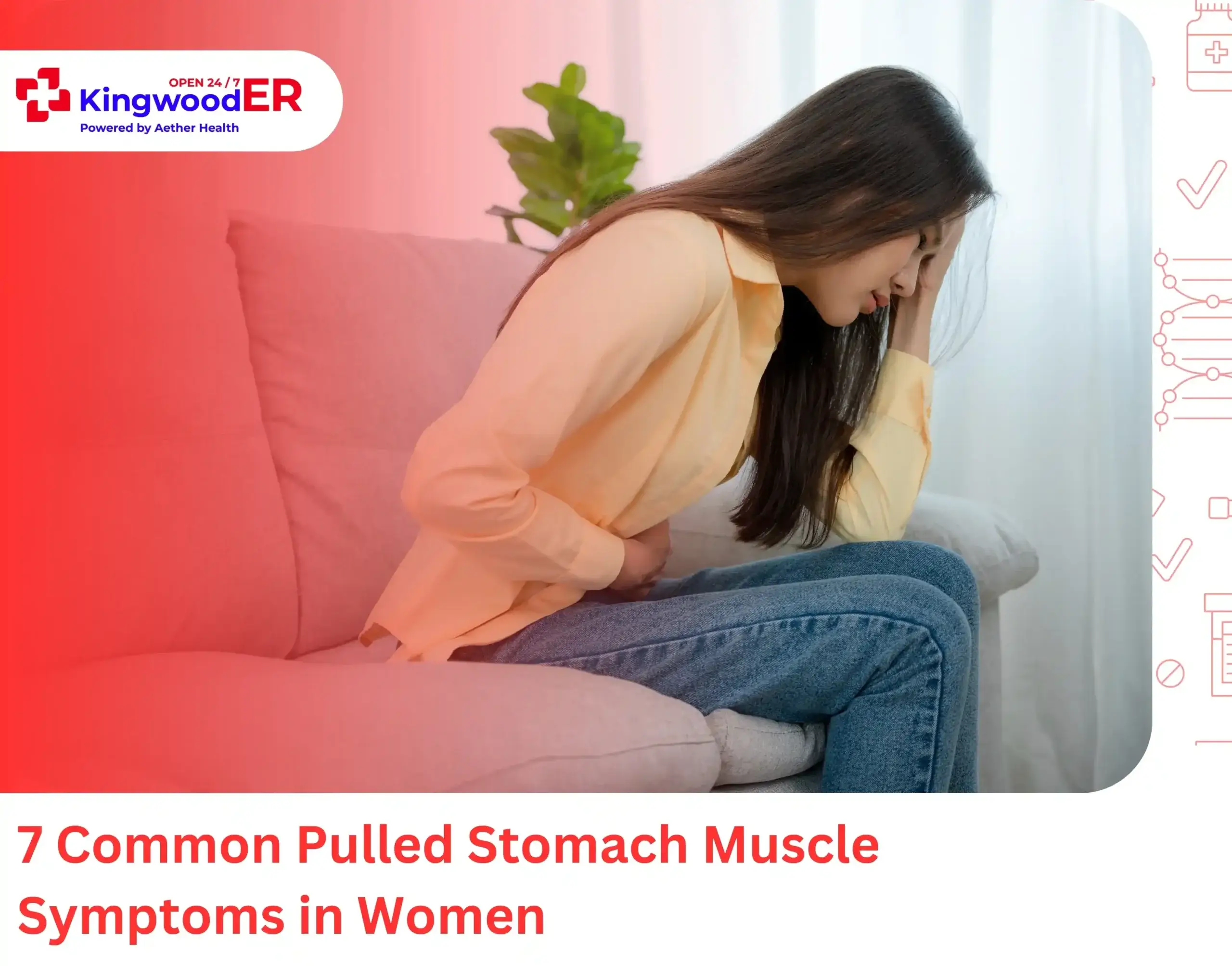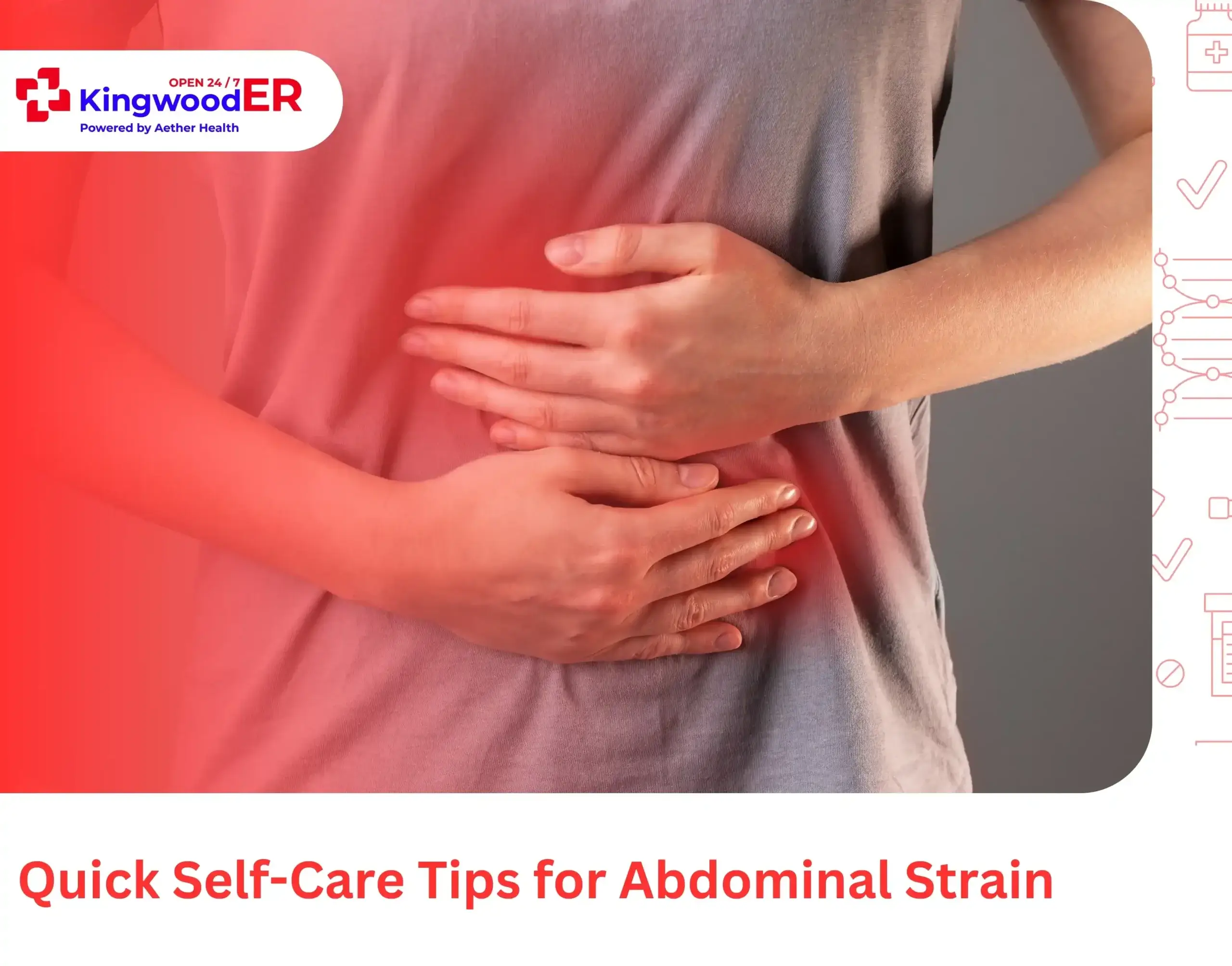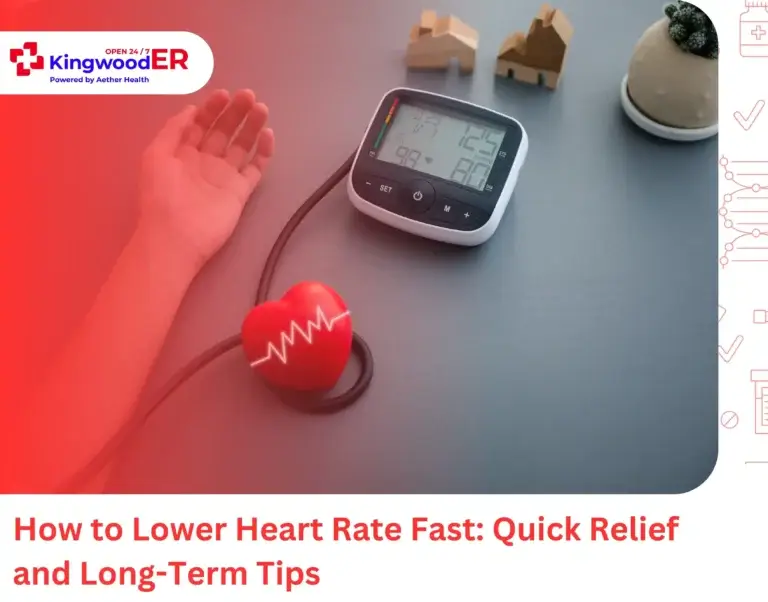A pulled stomach muscle, also called an abdominal strain, happens when the muscles in the stomach area are stretched too far or torn. These muscles are part of your core and help you move, bend, and support your posture.
For women, this pain can be worrying because abdominal pain signals various gynecological issues. If you don’t know what a pulled stomach muscle feels like, you may either panic for no reason or, worse, overlook a problem that needs urgent care.
So, let’s go through pulled stomach muscle symptoms.
7 Common Pulled Stomach Muscle Symptoms in Women

Here’s what you girls may feel if you’ve pulled or strained an abdominal muscle:
1. Sharp or sudden pain
Unlike period pain, which tends to feel crampy and spread out, a muscle strain usually stays localized, often worsening when you move, cough, or laugh.
2. Tenderness to the Touch
If the area feels sore or sensitive when pressed, that’s a strong sign of a strain.
3. Swelling or Mild Bruising
With more severe strains, you may notice swelling, discoloration, or a lump in the abdominal wall. Bruising can show up a day or two after the injury.
4. Muscle Spasms or Tightness
Sometimes the body reacts to injury with protective muscle contractions. You may feel your stomach muscles tighten up or spasm unexpectedly. This can make stretching and standing difficult.
5. Pain That Worsens With Movement
It is one of the specific pulled stomach muscle symptoms. Unlike digestive pain, which might come and go regardless of movement, muscle pain in women tends to flare when the injured area is activated and eases when you rest.
6. Difficulty With Daily Activities
Women with a pulled stomach muscle may find it harder to do simple activities like carrying a baby. The pain can sometimes cause stiffness in the back or hips.
7. Distinguishing Muscle Strain From Other Causes
This is the tricky part. Because abdominal pain can point to serious conditions like appendicitis, gallstones, kidney infections, or gynecological issues, women often worry when they feel sudden stomach pain.
How Pulled Stomach Muscle Symptoms Differ From conditions
- Muscle strain: Pain worsens with movement, is tender to touch, and may improve with rest.
- Appendicitis: Pain starts near the belly button and moves to the lower right side, often with fever, nausea, or loss of appetite.
- Gallbladder pain: Sharp pain in the upper right abdomen, sometimes radiating to the back or shoulder. If it goes up on the right side, it might show gall bladder polyps or stones.
- Gynecological causes: Pain related to menstrual cycle, ovulation, or ovarian cysts, often deep and crampy.
If you’re unsure, it’s always better to get checked out at an emergency room, especially if the pain is severe, sudden, or comes with other concerning symptoms.
How Do You Pull a Muscle in Your Stomach?
You can strain your stomach muscles in various ways. For instance, lifting heavy objects, sudden twisting, intense workouts, sports injuries, or repeated coughing and sneezing. Sometimes, everyday activities like reaching for something on a high shelf can also trigger it.
Why Pulled Stomach Muscle Pain Feels Different from Other Stomach Pain
Unlike pain from the stomach or digestive system, muscle strain pain typically worsens when you move, stretch, or apply pressure to the affected area. It may feel sharp during movement and more like an ache when you rest.
Why Women Should Pay Special Attention
Abdominal pain in women isn’t always straightforward. A pulled stomach muscle can feel similar to other conditions, such as menstrual cramps, ovarian cancer, urinary tract infections, or early pregnancy discomfort. This makes it harder to figure out what’s going on.
Special Considerations During Pregnancy and Postpartum
Pregnancy puts extra pressure on the abdominal muscles, which can make them prone to injury. After childbirth, the muscles may still be weak, and certain movements or lifting can cause strain. In both cases, it’s important to avoid dismissing pain as “normal” without checking with a doctor.
Quick Self-Care Tips for Abdominal Strain

If you think your pulled stomach muscle symptoms aren’t severe, you can try these simple steps at home while you arrange to see a doctor:
- Rest Your Core: Avoid activities that exacerbate the pain, such as lifting, twisting, or engaging in intense exercise. Give your muscles time to heal.
- Apply Ice Packs: Place a cold pack or wrapped ice on the sore area for 15–20 minutes at a time, several times a day, especially in the first 48 hours. This can help reduce swelling and pain.
- Use Gentle Support: Wearing a light abdominal support band or gently holding the area with your hand during movement can ease strain.
- Switch to Heat After Two Days: After the first 48 hours, using a warm compress or heating pad can help relax tight muscles and improve blood flow.
- Stay Hydrated and Eat Light: Dehydration can exacerbate muscle cramps. Drink enough water, and choose light meals to avoid adding pressure to your core.
- Move Carefully: If you need to get up, roll to your side first, then push yourself up with your arms. This puts less stress on your stomach muscles.
When to Head to the ER for Pulled Stomach Muscle

Most pulled stomach muscle symptoms heal with rest, ice, and gentle care at home. However, stomach pain can sometimes be a sign of a more serious condition that requires urgent medical attention. Head to your nearest emergency room if you experience:
- Severe or Worsening Pain
- Difficulty Moving or Breathing
- Not Improving with Rest and Ice
- Pain with Other Concerning Symptoms such as Fever or chills, nausea or vomiting (especially if vomiting blood), dizziness or fainting. Swelling or a hard, tight belly, and blood in your stool or urine also warrants emergency intervention.
Final Thoughts: Why Acting Early Matters
Ladies, don’t push your health to the side in the middle of your busy routine. If pulled stomach muscle symptoms are severe, unusual, or accompanied by other concerning signs, it’s time to have it checked.
At Kingwood ER, we’re here for you 24/7 with on-site ultrasound to quickly find out what’s going on and get you the right care. Women’s abdominal muscles carry extra responsibilities (pregnancy, menstruation, daily physical demands); they deserve more care.
FAQs
1. How long does it take for a pulled stomach muscle to heal?
Mild strains can typically heal within 1–2 weeks with rest and proper care. More severe tears may take 4–6 weeks or longer to heal. Recovery time depends on the severity of the muscle injury and how closely you follow self-care instructions.
2. Can a pulled stomach muscle feel like period pain?
Yes, in women, abdominal strain can feel similar to menstrual cramps or ovarian discomfort. The difference is that muscle strain pain typically worsens when you move, twist, or press on the affected area.
3. How does abdominal pain feel if it’s from an ovarian cyst rupture?
The pain from a ruptured ovarian cyst is usually sudden, sharp, and one-sided in the lower abdomen. It can spread to your back or thighs and may come with bloating, nausea, or dizziness. Unlike a pulled stomach muscle, this pain feels deeper inside and often needs urgent medical attention.
4. When should I go to the emergency room for stomach pain?
Go to the ER if your pain is sudden, severe, or getting worse, or if you have other symptoms like fever, vomiting, blood in stool or urine, dizziness, or trouble breathing.




